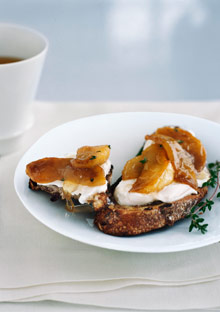O's Guide to Fresh Cheese

Photo: Tara Donne
Fresh cheese—in all its light, silky, delicate permutations—adds tang and lushness to warm-weather pastas, salads, and desserts. Lise Funderburg counts the ways.
As hot weather descends, the urge to fuss over food evaporates. We eat lighter meals, steer clear of stoves, and favor recipes that utilize the seasonal produce filling local markets. This is not, in other words, the time for crown roasts.That's where fresh cheeses come in. They are a perfect, heat-beating mainstay of summer menus, according to Susan Spungen, food editor and author of Recipes: A Collection for the Modern Cook. Fresh cheeses retain the pure, sometimes chalky whiteness of milk, so they set off the bright colors of summer fruits and vegetables, and they aren't especially filling. All are characteristically moist and mild, whether the milk they came from was cow, goat, or yak.
Fresh cheeses include supermarket familiars like cream cheese and mozzarella, as well as queso fresco, halloumi, and Quark. Unlike the complex flavors of a Cheddar that's been aged eight years or a Roquefort veined with mold, a fresh cheese won't knock you over the head with personality. It will, however, provide a beguiling counterpoint to a variety of other ingredients. "Fresh cheeses play well with others," Spungen says. A mascarpone, for example, can be stirred into a savory risotto or whipped with brown sugar and served alongside fresh strawberries as a dessert.
Most cheeses start out the same way, according to food scientist Harold McGee, author of On Food and Cooking. Enzymes and acids are added to milk or allowed to develop naturally in it; they chemically provoke its proteins and fats (the tasty parts) to clump into curds, leaving behind a watery excess known as whey. And here lies the fork in the cheesemaking road: Fresh cheeses receive little further doctoring. Panir, from India, is ready to use as soon as the whey is squeezed out; the curds for feta, from Greece, are drained, molded, brined, then good to go.
Before pasteurization and refrigeration were invented, such quick-to-make cheeses were the rural farmer's way of dealing with excess milk production. But today these cheeses are delicacies. Spungen keeps a handful of different types in her refrigerator for last-minute summer entertaining. For an impromptu brunch, she'll serve fruit on toasted brioche, topped with Quark and drizzled with honey. Dinner might be a salad of prosciutto, peaches, and warm goat cheese disks. And for dessert, she'll spoon some ricotta onto a berry compote.
As personable as these cheeses may be, their charms are fleeting. The high moisture content translates to a shorter shelf life: Aficionados of handcrafted mozzarella argue that its life span is measured in hours. Mold may be essential to a Stilton, but it's not part of the fresh cheese profile, Spungen warns, so if your goat cheese button starts to turn colors, best to throw it out and start, well, fresh.
Your glossary to choose fresh cheeses



